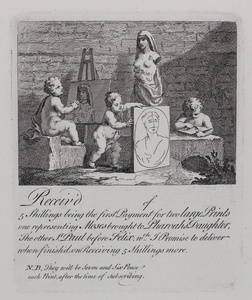| Method | Etching |
| Artist | William Hogarth |
| Published | [J & J Boydell c.1802] |
| Dimensions | Image 90 x 120 mm, Plate 150 x 126 mm |
| Notes |
Hogarth's reworking of Boys Peeping at Nature, a print that was reused a number of times as the subscription ticket for Hogarth's works. The original image, executed in 1731, was done as the receipt for Hogarth's 'A Harlot's Progress.' The print depicted a group of three putti examining the antique cult statue of the Ephesian Diana. The statue, which originally stood in the Great Temple of Artemis in the Ionian Greek city of Ephesus, is easily identified by its multiple breasts, originally intended to emphasise the fertility and abundance of the Virgin Mother Goddess. In the original state, one cherub paints an idealised version of the statue, while another, turning his back on Nature, draws from his imagination. The centre of the scene originally depicted a satyr attempting to view the goddess' genitals while the third cherub tried to hold him back. The scene created an appropriate double entendre, being simultaneously an exhortation for art to return to its origins, and an overt advertisement of the allure of 'nature' at its basest, an appropriate gloss for the forthcoming Harlot. In 1737, the print was reused, unchanged but for its inscription, as the subscription ticket for the 'Four Times of the Day' and 'Strolling Actresses.' In 1751, the print was reworked, as it appears here, for reuse as the subscription ticket for 'Moses brought to Pharaoh's Daughter' and 'Paul before Felix.' The original design being no longer appropriate for the mood of the new engravings, Hogarth replaced the peeping satyr with a large canvas featuring a cartoon of an idealised female portrait head, and altered the appearance of the statue. Below the image, the inscription for the receipt reads: 'Receiv'd of 5 Shillings being the first Payment for two large Prints one representing Moses brought to Pharoah's Daughter, The other St. Paul before Felix. wch. I Promise to Deliver when finish'd, on Receiving 5 Shillings more. N.B. They will be Seven and Six Pence each Print, after the time of subscribing.' William Hogarth (1697 - 1764) was born in London, the son of an unsuccessful schoolmaster and writer from Westmoreland. After apprenticeship to a goldsmith, he began to produce his own engraved designs in about 1710. He later took up oil painting, starting with small portrait groups called conversation pieces. He went on to create a series of paintings satirising contemporary customs, but based on earlier Italian prints, of which the first was The Harlot's Progress (1731), and perhaps the most famous The Rake's Progress. His engravings were so plagiarised that he lobbied for the Copyright Act of 1735, commonly referred to as 'Hogarth's Act,' as a protection for writers and artists. During the 1730s Hogarth also developed into an original painter of life-sized portraits, and created the first of several history paintings in the grand manner. Paulson 120 iv/iv, BM Satires 1943 Condition: Excellent impression with wide margins. Minor time toning to edges of sheet. |
| Framing | unmounted |
| Price | £100.00 |
| Stock ID | 50664 |

